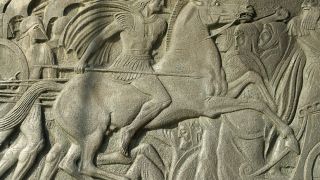Who was Daniel in the Bible?
Roughly 2,600 years ago a Judean teenager was taken captive by the rapidly ascending Babylonian Empire—a governmental juggernaut of unstoppable military strength, great wealth and technological advancement. While such an event normally led to a life of misery as a slave, God had something else in mind for this young man.
Daniel—the teenager who had been taken captive—came to realize that God was miraculously working with him, and not just to preserve his life. God was revealing through him major prophecies of future world-ruling empires.
As a resident of the world’s premier capital city and an honored wise man in King Nebuchadnezzar’s court, Daniel demonstrated God’s superiority over the pagan gods of Babylon. He also left a legacy of faithful obedience to God in spite of grave trials and difficulty.
Here are some of the key issues regarding the book of Daniel that are covered in articles in this section of our website.
The book of Daniel
The book of Daniel is one of the most intriguing books in the Old Testament. Because its author, Daniel, was recognized for his wisdom (Daniel 1:17; 2:14), his work is included in the Writings section, also called the wisdom section, of the Old Testament in the Jewish canon.
Today we find the book of Daniel in the prophets section of the Old Testament in English Bibles, and this location is supported by Christ’s recognition of Daniel as a prophet (Matthew 24:15) and by the similarities between the book of Daniel and the New Testament book of Revelation.
Not only do both Daniel and Revelation contain end-time prophecy, but both books are also written in a similar style, known as apocalyptic writing.
Another little-known fact about the book of Daniel is that approximately half of it was written in Hebrew (as were the other books of the Old Testament), and approximately half of it in Aramaic, another language used only sparsely in the Bible. Daniel has the largest collection of Scripture that was originally written in Aramaic.
For a more thorough explanation of what makes the book of Daniel so interesting and how it complements the book of Revelation, see the article “The Book of Daniel.”
To learn more about the use of Aramaic in the Bible, which includes the book of Daniel, see “Biblical Aramaic.”
If you would like to learn about the style of writing used in the book of Daniel, read the article “Apocalyptic Literature.”
Daniel’s friends: Shadrach, Meshach and Abed-Nego
Few people know Daniel’s three friends by their original Hebrew names: Hananiah, Mishael and Azariah. Fewer still know what their Babylonian names mean and why they were likely given these names.
Although Daniel’s three friends also served with him in King Nebuchadnezzar’s Babylonian government, they are likely best known for their example of faith in refusing to bow down to an image created by the king.
After being told that they would be thrown into a fiery furnace if they did not worship the image, the three respectfully told the monarch that they would not do so. They explained that their God could save them, but even if He did not, they would not bow down to the king’s image.
While understanding the background of the names of Daniel’s friends is interesting information, these men’s outstanding examples of faith are much more important. Their tests of faith in regard to their diets and threats of the loss of their lives remain as timeless encouragement for us today to live similarly.
Read more about these issues in the article “Daniel’s Three Friends.”
Nebuchadnezzar’s statue
The book of Daniel contains much prophecy—some that has been fulfilled and some that will be fulfilled in the future. The prophecy in this book begins in chapter 2 with King Nebuchadnezzar of the Babylonian Empire receiving a strange dream of a great image. God, through Daniel, revealed that this dream meant that three great world-ruling empires would follow after the Babylonian Empire.
The successive empires following Babylon did occur. We now await a revival of the last empire noted in Nebuchadnezzar’s dream—a revival that is prophesied to exist at Christ’s return. Nebuchadnezzar’s dream indicates that when Jesus returns to earth, another kingdom will conquer all the human governments and remain forever. Other prophecies make it clear that this kingdom is the coming Kingdom of God.
Overlooked by many, this prophecy was an important part of Jesus’ teaching when He came to earth as a human. As Mark 1:14 explains: “Now after John was put in prison, Jesus came to Galilee, preaching the gospel of the kingdom of God.” In other words, the prophecy God gave through Nebuchadnezzar’s dream was relevant in Jesus’ day—and it continues to be relevant today.
For a closer examination of the prophecy revealed in Nebuchadnezzar’s dream of the great image, see the article “Daniel 2.”
Nebuchadnezzar’s edict
There are plenty of bad guys in the Bible—people who disobeyed God and inflicted much pain and suffering upon others. But there is only one such person whose words comprise an entire chapter in the Bible. This person is the king who destroyed the temple in Jerusalem and carried thousands of Jews captive to Babylon—King Nebuchadnezzar.
While most people, especially kings, don’t like to admit their faults, King Nebuchadnezzar had an experience that led him to share his mistake and punishment from God via an edict written to all nations and peoples. God ensured that this king’s message was recorded in His Word because it still has relevance for us today.
Learn the details in the article “The Gospel According to Nebuchadnezzar.”
Interpretation of dreams
Two of the ways God communicated with people in the Old Testament were through dreams and visions. These closely related means of communication figure prominently in the book of Daniel. King Nebuchadnezzar and Daniel are the primary individuals with whom God communicated in the book of Daniel.
A key principle related to these messages from God is that when God sends such a message, He also provides a means for clearly understanding what has been communicated. Approximately eight of these instances are found in the book of Daniel.
To see a chart listing these occurrences and further explanation of how Christians should view dreams today, see the article “Interpretation of Dreams.”
Daniel in the lions’ den
The account of Daniel’s being thrown into a den of lions is found in Daniel chapter 6. Most people know the outcome of the story—that God miraculously protected Daniel and that the men who accused Daniel of being disloyal to the king suffered the very fate they had tried to bring on Daniel.
But there is more to the story.
This story is also about how Daniel prayed to God, and it is about Daniel’s faith to continue to honor God through prayer even though a government edict forbade him to do so. In this story we are also reminded that even though God allowed the nation of Judah to fall to the Babylonians and permitted many of the Jewish people, including Daniel, to be taken captive, God was still the all-powerful God. He was superior to the Babylonian gods, and He could still protect those who honored Him.
This narrative reminds us that God has a history of intervening in the lives of those who love Him. To see a fuller explanation of this timeless story, see the article “Daniel 6: Daniel in the Lions’ Den.”
Four beasts, 10 horns and a little horn
Sometimes the Bible repeats a story, a historical record or a prophecy for emphasis. The prophecy that was revealed to King Nebuchadnezzar in Daniel 2, that there would be four world-ruling empires, was repeated about 50 years later in Daniel 7. This time, however, the message came directly to Daniel, and there were added details.
In this vision Daniel saw four beasts—representing the same four world-ruling empires that were described in Daniel 2—come up out of the sea. But in this vision Daniel noted that there was also a little horn that spoke pompous words against God and made war against the saints.
Daniel 7 also gives greater explanation of the fourth beast, which had 10 horns, representing 10 kings that would arise from this fourth kingdom. This prophecy concludes with more about the establishment of the Kingdom of God.
A detailed explanation of this vision is available in the article “Daniel 7: Four Beasts and the Little Horn.”
Ancient of Days
In Daniel 7 we find three references to a being called the “Ancient of Days” (verses 9, 13, 22). This is the only chapter in the Bible where we find this name.
For analysis of these passages to determine who this being is, see the article “Ancient of Days.”
The vision of a ram and a goat
In the eighth chapter of the book of Daniel there is further revelation of the details regarding the world-ruling empires first identified in Daniel 2. In this chapter, Daniel sees in vision a ram with two horns and then a male goat with a single notable horn between his eyes conquering the ram. This chapter provides insight into the third world-ruling empire spoken of in Daniel 2 conquering the second world-ruling empire.
The historical fulfillment of this is Greece under Alexander the Great conquering the Medo-Persian Empire. For a careful study of the prophecy and additional explanation of what happened to Alexander’s kingdom following his untimely death, see “Daniel 8: The Vision of a Ram and a Goat.”
The 70-year prophecy of Jeremiah
The ninth chapter of the book of Daniel contains two well-known prophecies, both involving the number 70. The first prophecy is one of 70 years. This prophecy is known as the 70-year prophecy of Jeremiah because God gave it through Jeremiah.
A reference to this prophecy is found in the book of Daniel because Daniel happened to be studying this prophecy and came to understand its meaning. In general, the Jews were prophesied to experience 70 years of punishment for their sins via the Babylonian Empire.
There are two components to this prophecy with overlapping 70-year periods of time. For a full explanation, see “Daniel 9: The 70-Year Prophecy of Jeremiah.”
70 weeks of Daniel
The 70-weeks prophecy, also found in Daniel 9, is more complex and extensive in its duration than the 70-year prophecy of Jeremiah. While the latter has long been fulfilled, the 70-weeks prophecy dated the coming of Jesus Christ to earth and also identifies significant aspects of Jesus’ ministry.
Some of these aspects of Christ’s ministry were partially fulfilled, and other aspects of this prophecy are still awaiting fulfillment. For an insightful analysis of this prophecy, see “70 Weeks of Daniel: What Does the Prophecy Mean?”
Daniel 11: one of the most detailed prophecies in the Bible
Over the course of his life, Daniel had seen multiple changes in governments and world-ruling empires. He had experienced the fall of his beloved nation of Judah, been taken captive to Babylon and served in high government positions in both the Babylonian and Medo-Persian Empires.
Additionally, God had revealed to Daniel much prophecy about mankind’s history that would occur after he (Daniel) passed from the scene. This history included a brief understanding of the coming of the Messiah, as noted in Daniel 9, and it included some very detailed prophecies in Daniel 11 about the human governments that would arise and continue until the second coming of Jesus to earth.
Of particular interest to students of prophecy is Daniel’s reference to “the abomination of desolation” (Daniel 11:31; 12:11). In Daniel 11 this referred to events that occurred in Jerusalem around 168/167 B.C.
In chapter 12 the abomination is in the context of the “time of the end” (Daniel 12:4). Jesus later spoke of this same end-time event (Matthew 24:3, 15). For a thorough explanation of its historical and future fulfillments, see “What Is the Abomination of Desolation?”
Writing from his location in the Middle East, Daniel wrote of other powers coming into the region from the north and south. Daniel referred to these leaders as “the king of the South” and “the king of the North” (Daniel 11:5-6). Of special interest to us, verses 40-45 speak of these same powers waging war at “the time of the end.”
For additional insight into the prophecies of Daniel 11 relating to these end-time powers, see the articles “Daniel 11: The Most Detailed Prophecy in the Bible,” “The King of the North” and “The King of the South.”
Daniel 12: End-time events
While previous prophecies in the book of Daniel have touched upon end-time events, the final chapter gives special emphasis to this time period. Even though this will be “a time of trouble” unlike any other, the encouragement for God’s people is that after Christ returns they will receive eternal life and be glorified (verses 1-3).
A brief reference to the resurrections is found in verse 2. Verse 4 shows that indications of the end time will be mankind’s ability to travel and an explosion of knowledge.
For further explanation of these prophecies, how long this time of trouble will last, and the correlation of these prophecies with Christ’s teaching, see the article “Daniel 12: End-Time Events.”
Angels
Angels are spoken of in at least 34 books of the Bible, including the book of Daniel. While there are a vast number of angels, we know very few of their names. The Bible provides the names of only three of these spirit beings, and the book of Daniel provides two of these.
For a study of angels in the Bible, see the introductory article for a subsection of our website titled “Angels.”
And be sure to read the articles throughout this “Understanding the Book of Daniel” section of our website to discover God’s outline of world-ruling empires and a message of hope for the future.




















